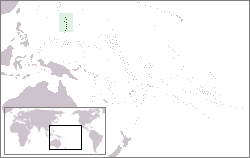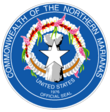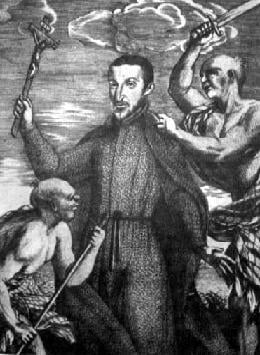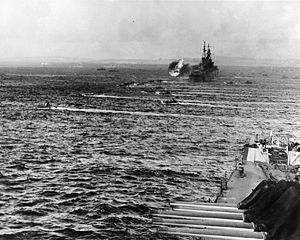Difference between revisions of "Northern Mariana Islands" - New World Encyclopedia
Mike Butler (talk | contribs) m |
Mike Butler (talk | contribs) m |
||
| Line 184: | Line 184: | ||
'''Other''' | '''Other''' | ||
| − | *[http://www.lonelyplanet.com/destinations/pacific/northern_mariana_islands/history.htm | + | *[http://www.lonelyplanet.com/destinations/pacific/northern_mariana_islands/history.htm Northern Mariana Islands] ''lonelyplanet.com'', observed December 18, 2006. |
| − | *[http://marshall.csu.edu.au/MJHSS/ Micronesian Journal of the Humanities and Social Sciences] | + | *[http://marshall.csu.edu.au/MJHSS/ Micronesian Journal of the Humanities and Social Sciences] Digital Micronesia, observed December 18, 2006. |
| − | *[http://cnmi.humanities.org.mp/encyclopedia/ Northern Mariana Islands Online Encyclopedia | + | *[http://cnmi.humanities.org.mp/encyclopedia/ Northern Mariana Islands] Northern Mariana Islands Online Encyclopedia, observed December 18, 2006. |
| − | *[http://www.micsem.org/home.htm Micronesian Seminar] | + | *[http://www.micsem.org/home.htm Micronesian Seminar] micsem.org, observed December 18, 2006. |
| − | *[http://jetapplicant.blogspot.com The Saipan Blog] | + | *[http://jetapplicant.blogspot.com The Saipan Blog] observed December 18, 2006. |
| − | *[http://www.msmagazine.com/spring2006/paradise.asp | + | *[http://www.msmagazine.com/spring2006/paradise.asp Paradise Lost: Greed, Sex Slavery, Forced Abortions and Right-Wing Moralists, by Rebecca Clarren] ''MS Magazine, Spring, 2006''. |
| − | *[http://www.npr.org/templates/story/story.php?storyId=5408446 Fresh Air (NPR): "Sweatshops in U.S. Territory"] | + | *[http://www.npr.org/templates/story/story.php?storyId=5408446 Fresh Air (NPR): "Sweatshops in U.S. Territory"] ''NPR'', observed December 18, 2006. |
| − | *[http://www.hartford-hwp.com/archives/24/017.html "Neo-Colonialism & Contract Labor Under The U.S. Flag" by Phil Kaplan] | + | *[http://www.hartford-hwp.com/archives/24/017.html "Neo-Colonialism & Contract Labor Under The U.S. Flag" by Phil Kaplan] observed December 18, 2006. |
| − | *[http://bc.edu/bc_org/avp/law/lwsch/journals/bciclr/24_2/06_FMS.htm "Solving Worker Abuse Problems in the Northern Mariana Islands" by Karen M. Smith] | + | *[http://bc.edu/bc_org/avp/law/lwsch/journals/bciclr/24_2/06_FMS.htm "Solving Worker Abuse Problems in the Northern Mariana Islands" by Karen M. Smith] Boston College Journal, observed December 18, 2006. |
| − | *[http://saipansucks.com/about.htm | + | *[http://saipansucks.com/about.htm About Saipan] ''saipansucks.com'', observed December 18, 2006. |
| − | *[http://visibleearth.nasa.gov/cgi-bin/viewrecord?25329 Satellite Image of Anatahan Ash Plume] | + | *[http://visibleearth.nasa.gov/cgi-bin/viewrecord?25329 Satellite Image of Anatahan Ash Plume] ''NASA - Visible Earth'', observed December 18, 2006. |
| − | *[http://www.oceandots.com/pacific | + | *[http://www.oceandots.com/pacific.html Mariana Islands] ''Oceandots.com'', observed December 18, 2006. |
| − | |||
| − | |||
| − | |||
| − | |||
{{credit|81160689}} | {{credit|81160689}} | ||
Revision as of 19:48, 17 December 2006
| |||||

| |||||
| Official languages | English, Chamorro, Carolinian. | ||||
| Capital | Saipan | ||||
| Head of State | George W. Bush | ||||
| Governor | Benigno R. Fitial | ||||
| Lieutenant Governor | Timothy P. Villagomez | ||||
| Resident Representative | Pedro Agulto Tenorio | ||||
| Area - Total - % water |
Ranked 195th 477 sq km Negl. | ||||
| Population - Total (2005) - Density |
Ranked 198th 80,801 (July 2005 est.) 168/km | ||||
| Independence | none (in political union with the USA) | ||||
| Currency | Dollar | ||||
| Time zone | UTC+10 | ||||
| National anthem | Gi Talo Gi Halom Tase (Chamorro) Satil Matawal Pacifico (Carolinian) | ||||
| Internet TLD | .mp | ||||
| Calling Code | +1 670 | ||||
The Northern Mariana Islands, officially the Commonwealth of the Northern Mariana Islands, is a commonwealth in political union with the United States of America at a strategic location in the western Pacific Ocean. It consists of 15 islands about three-quarters of the way from Hawaii to the Philippines. Its indigenous people are the Chamorros, who first populated the island approximately 4000 years ago. The capital, Saipan, provided one take-off point for the bombing of Hiroshima, which brought about the defeat of Japan in the Second World War.
Geography
The Northern Mariana Islands—together with Guam to the south—comprise the Mariana Islands. They are the southern part of a submerged mountain range that extends 2519 kilometers from Guam to near Japan. The Marianas are the northernmost islands of a larger island group called Micronesia.
The land area of the Northern Mariana Islands is 477 square kilometres, 2.5 times the size of Washington, DC.
The southern islands are limestone with level terraces and fringing coral reefs. The northern islands are volcanic, with active volcanoes on Anatahan, Pagan Island and Agrihan. The volcano on Agrihan is the highest elevation in the islands at 965 meters.
Anatahan Volcano is a small volcanic island located 120km (80 miles) north of Saipan Island and 320km (200 miles) north of Guam. The island is about nine kilometers (5.6 miles) long and three kilometers (two miles) wide. Anatahan began erupting suddenly from its east crater in May 2003. Since then it has continued to alternate between eruptive and calm periods. On April 6, 2005, approximately 50,000 cubic meters of ash and rock were ejected, causing a large, black cloud to drift southward over Saipan and Tinian. Recent eruptions have caused some commercial flights to re-route.
The islands have a tropical marine climate moderated by seasonal northeast trade winds. There is little seasonal temperature variation. The dry season runs from December to June, and the rainy season from July to October can include typhoons. The Guinness Book of World Records has cited Saipan as having the most equable temperature in the world.
The primary natural resource is fish, which causes conflict with the protection of endangered species. About one-fifth of the land is arable, another tenth is permanent pasture. Past development has created landfills that must be cleaned up and has caused contamination of groundwater on Saipan, which may contribute to disease. Saipan, Tinian, and Rota have the only ports and harbors, and are the only permanently populated islands.
History
Guam was first discovered by sea-faring people who migrated from Indonesia or the Philippines around 2000 B.C.E., according to legends and myths, archaeological evidence, Jesuit missionary accounts, and observations from visiting scientists.
The first European to discover the island group was Ferdinand Magellan who on March 6, 1521, observed the two southernmost islands, sailed between them. Magellan's crew called the islands “Islas de los Ladrones” (The Island of Thieves). The common account for this naming resulted from the theft of a boat from Magellan's ship, which may, in fact, have stemmed from cultural differences around private property.
General Miguel López de Legazpi claimed Guam for Spain in 1565. Spanish colonization commenced in 1668 with the arrival of Padre San Vitores, who established the first Catholic mission.
Guam, along with the rest of the Mariana and Caroline islands, were then governed as part of the Spanish East Indies from the Philippines. Between 1668 and 1815, Guam was an important resting stop on the Spanish trade route between Mexico and the Philippines. The original population dwindled significantly as a result of disease and rebellion against the Spaniards. Much of the adult male population was killed. In 1668, the Chamorros, who were typical Micronesians, with a considerable civilization, were estimated at 40,000 to 60,000, but less than a century later only 1800 remained.
The Marianas came under German control for a brief period when Spain sold them to Germany, exclusive of Guam. In 1919 the Japanese invaded and occupied these islands and the League of Nations awarded them to Japan by mandate. The Japanese used the islands as a military outpost.
During World War II, Japanese armed forces invaded Guam on December 8, 1941. Chamorros from the Northern Mariana Islands were brought to Guam to serve as interpreters and in other capacities for the occupying Japanese force. The Guamanian Chamorros were treated as an occupied enemy. They were subjected to forced labor, family separation, incarceration, execution, concentration camps and prostitution. That, as well as information divulged under torture, caused lasting grudges between the Chamorros of Guam and Saipan.
The United States returned and fought the Battle of Guam in July 21, 1944, to recapture the island. The U.S. also won the bitterly fought three-week Battle of Saipan to capture and occupy the Northern Marianas. Guam and Saipan provided the take off point for the bombing of Hiroshima. When the armistice was signed the war was over for everyone except one Japanese soldier, who continued hiding out in Guam until 1990. His family thought that he had been killed in action.
In 1947, the Northern Mariana Islands became part of the post-World War II United Nations Trust Territory of the Pacific Islands. Thus, defense and foreign affairs became the responsibility of the U.S.
In 1976, Congress approved a Commonwealth of the Northern Mariana Islands in political union with the United States. The commonwealth government adopted its own constitution in 1977, and the constitutional government took office in January 1978. The Covenant was fully implemented on November 3, 1986, when United States citizenship was conferred on legally qualified commonwealth residents.
On December 22, 1990, the Security Council of the United Nations terminated the trust territory agreement as it applied to the Northern Mariana Islands and five other [the Marshall Islands and the Federated States of Micronesia (Chuuk, Kosrae, Pohnpei and Yap)] of the trust’s original seven districts.
Federal law applies to the Northern Mariana Islands. However, the islands are outside the customs territory of the United States and, although the internal revenue code does apply in the form of a local income tax, the income tax system is largely locally determined. Federal minimum wage and federal immigration laws do not apply to the territory.
Politics
Politics of the Northern Mariana Islands takes place in a framework of a presidential representative democratic system, whereby the Governor is head of government, and of a pluriform multi-party system. The Northern Mariana Islands are a commonwealth in political union with the United States.
Executive power is exercised by the government. Legislative power is vested in both the government and the two chambers of parliament. The house of representatives has 18 members, elected for a two-year term in single-seat constituencies. The senate has nine members, elected for a two-year term in single-seat constituencies. The commonwealth has an elected official or "resident representative" located in Washington, DC who speaks for the commonwealth on national issues.
The judiciary is independent of the executive and the legislature. It comprises the Commonwealth Supreme Court, the Superior Court, and the Federal District Court.
When United States citizenship was granted in 1986 to people who qualified as descendents of the Northern Marianas, few among the island's native population had been adequately prepared for democracy. As a result, politics in the Northern Mariana Islands is often more a function of family relationships and personal loyalities where the size of one's extended family is more important than a candidate's personal qualifications. Critics say that this is nepotism carried out within the trappings of democracy.
Administratively, the Northern Mariana Islands are divided into four municipalities. Islands one through 11 are collective known as the Northern Islands, together forming the Northern Islands Municipality. Islands 12 through 15 are collectively known as the Southern Islands, with the municipalities Saipan, Tinian, and Rota (uninhabited Aguijan is part of Tinian municipality). Because of volcanic threat, the northern islands have been largely evacuated, with just six people remaining on Alamagan island in 2000. The mayor of the Northern Islands Municipality resides on Saipan.
Economy
The Northern Mariana Islands benefit from substantial subsidies and development assistance from the federal government of the United States. The economy relies heavily on a declining tourism sector, especially, from Japan, and the rapidly dwindling garment manufacturing sector. The tourism industry is also dwindling. Since late 2006, tourist arrivals fell 15.23 percent (73,000 potential visitors) from the 11 months prior.
The Northern Mariana Islands has capitalized on its position as a free trade area with the U.S., while not being subject to U.S. labor laws. This allows garments to be labelled "Made in USA" without having to comply with all U.S. labor laws. There have been allegations of sweatshops, child labor, child prostitution and even forced abortions.
An immigration system outside of federal U.S. control has resulted in a large number of Chinese migrant workers employed in the islands' garment trade. However, when World Trade Organisation restrictions on Chinese imports to the US were lifted, a number of garment factories closed in the Northern Mariana Islands.
Agricultural production, primarily of tapioca, cattle, coconuts, breadfruit, tomatoes, and melons exists, but is of relatively minor economic importance.
GDP per capita was $9300 in 1996. The World Fact Book supplied no total for exports, saying it was not applicable. Garments were the sole export commodity, and the U.S. was the sole export partner. Likewise, there was no total for imports. Import commodities included food, construction equipment and materials, and petroleum products. Import partners were Japan and the U.S.
The islands have over 350 kilometers of highways, three airports with paved runways (one some 3000 meters (9840 feet) long; two around 2000 meters (6560 feet), three airports with unpaved runways (one about 3000 meters long; two under 1000 meters (3280 feet)), and one heliport.
Demographics
The population of the Northern Mariana Islands grew from 16,780 in 1980 to an estimated 82,459, in 2006. Most of this nearly 500 percent growth was in the form of migration from Asia in response to unprecedented economic growth. People living there have a life expectancy of 76.09 years.
Filipinos are the largest overall ethnic group in the Northern Mariana Islands, making up over 29 percent of the population. Both the Filipino and Chinese (22.1 percent ) populations have surpassed the indigenous Chamorros (21.3percent) in population. The original inhabitants of the Northern Mariana Islands refer to themselves as Chamorros (“tsa-'mor-os”). At the time of Magellan's arrival in 1521, the term “chamorri” designated the upper caste. By 1668, the term had changed to “chamorro” (meaning “bold"), because Chamorro men wore a topknot of hair on a shaved scalp, according to J. Jerome Smith (http://www.everyculture.com). .
While 85 percent of the population are baptized into the Roman Catholic faith or belong to another Christian denomination, animistic beliefs persist, including a respect for ancestral spirits, or “taotaomo'na,” who are believed to occupy certain trees and other areas in the forests. Chamorros believe that their ancestors have lived in the Mariana Islands since the dawn of time, that the Mariana Islands are center of the universe and all human life began in Guam. While Spanish Catholic missionaries abolished the practices of “makahna,” who mediated between the spiritual and physical world, many persist. There is an enduring belief in the existence of persons' spirits beyond their physical life. Every year on All Soul's Day, Chamorros remember their ancestors by holding memorial services and decorating their graves with flowers, candles, photographs, and other mementos.
Catholicism has heavily influenced family life in the Northern Mariana Islands. Marriage is a matter of personal romantic love and is monogamous. Few adults remain unmarried, and large families are favored. Newly married couples may remain with the bride's family until children are born, when an independent nuclear household is established. Larger extended family households may develop, although the married couple and children tend to live independently
Languages were Philippine languages 24.4 percent, Chinese 23.4 percent, Chamorro 22.4 percent, English 10.8 percent, other Pacific island languages 9.5 percent, other 9.6 percent, including Carolinian, an Eastern Malayo-Polynesian language that combines dialects from the area of Truk. Chamorro is closely related to Tagalog (Pilipino). After more than four hundred years of Western (Spanish, German, and English) and Asian (Japanese) colonial domination, Chamorro is untouched in its grammar, although major portions of the vocabulary have been transformed into variants of Spanish and English.
Chamorros are used to being close together and often do not have to speak to communicate. When one encounters an older Chamorro, one is expected to at least nod with a bow or to kiss the elder's hand briefly as a sign of respect.
There are no large class differentials apart from migrant labor populations, which live in poorer economic conditions. The Northern Mariana Islands tend to be relatively homogeneous socially and economically.
Culture
A symbol of Chamorro strength, pride, resistance, and survival, is the latte stone, a megalithic structure used to elevate houses in the pre-colonial period. First built around 800 C.E., latte stones are large coral blocks composed of a trapezoidal stone pillar called a “haligi,” and a hemispherical cap called a “tasa.” Construction of these stones ceased after the onset of wars against Spanish colonizers. Jungle areas and sites in which latte stones are located are considered sacred. In pre-colonial years people buried family members beneath latte stones and thus ancestral spirits are assumed to reside there.
Rice dominates the diet, which is based of vegetables and marine resources. Most food is imported from Japan, Australia, and the United States. Normally, three meals a day are eaten at home — even for those working in towns. Families bring prepared food and additional food and drink for preparation on site for religious and secular ceremonies.
Siblings and neighbors form a network of caregivers for infants, who are rarely left alone. Chamorros value formal education. School age in the Marianas is from six to sixteen. Schools operate on the American model. There are preschool opportunities for the child under six years old. The Northern Marianas College on Saipan is a two-year school that offers degrees in education, liberal arts, and business. Students who wish continue their education attend the University of Guam or the University of Hawaii. Young people who leave the territory to complete their higher education often do not return. The literacy rate for the total population is 97 percent.
Chamorro folk music remains an important part of the islands' culture, though elements of music left by American, German, Spanish and Japanese colonizers can be seen. There are both Carolinian and Chamorro traditional chant styles. A variant of the Spanish cha-cha-chá is popular, as is a Caroline Islands "stick dance" which combines improvised percussion and foot stomping A well-known stick dance group is the Talabwog Men Stick Dancers.
The national anthem is "Gi Talo Gi Halom Tasi" (in Chamorro language, or "Satil Matawal Pacifico" in Carolinian), which was adopted on October 1996. The song's melody comes from a German tune. Music festivals include the Fiestan Luta, an annual celebration.
ReferencesISBN links support NWE through referral fees
Thomas, James O., “Trapped With The Enemy: Four years as a civilian POW in Japan,” ISBN: 1401044131
Denfeld, D. Colt, “Hold the Marianas: The Japanese Defense of the Mariana Islands,” White Mane Publications, 1997. ISBN 1572490144
Cunningham, Lawrence J. “Ancient Chamorro Society,” 1992.
Farrell, Don A., “History of the Northern Mariana Islands,” (Unknown Binding), 1991
McPhetres, Samuel F., “Commonwealth of the Northern Mariana Islands:” An article from “The Contemporary Pacific,” University of Hawaii Press, 2004
External links
Government
- The CNMI Covenant "Commonwealth Law Revision Commission," observed December 17, 2006.
- The CNMI Constitution "Commonwealth Law Revision Commission," observed December 17, 2006.
- H.R. 873 - the Northern Mariana Islands Delegate Act observed December 17, 2006.
- H.R. 5550 - The United States-Commonwealth of the Northern Marianas Human Dignity Act observed December 17, 2006.
Overviews
- Commonwealth of the Northern Mariana Islands Countries and Their Cultures No-Sa, observed December 17, 2006.
- Guam Countries and Their Cultures Ge-It, observed December 17, 2006.
- Northern Mariana Islands Open Directory Project, observed December 17, 2006.
- Moon Handbooks Micronesia South Pacific Organizer, observed December 17, 2006.
- Northern Mariana Islands myMicronesia, observed December 17, 2006.
- Northern Mariana Islands Digital Micronesia, observed December 17, 2006.
- Trust Territory of the Pacific Islands Archives University of Hawaii Library, observed December 17, 2006.
Other
- Northern Mariana Islands lonelyplanet.com, observed December 18, 2006.
- Micronesian Journal of the Humanities and Social Sciences Digital Micronesia, observed December 18, 2006.
- Northern Mariana Islands Northern Mariana Islands Online Encyclopedia, observed December 18, 2006.
- Micronesian Seminar micsem.org, observed December 18, 2006.
- The Saipan Blog observed December 18, 2006.
- Paradise Lost: Greed, Sex Slavery, Forced Abortions and Right-Wing Moralists, by Rebecca Clarren MS Magazine, Spring, 2006.
- Fresh Air (NPR): "Sweatshops in U.S. Territory" NPR, observed December 18, 2006.
- "Neo-Colonialism & Contract Labor Under The U.S. Flag" by Phil Kaplan observed December 18, 2006.
- "Solving Worker Abuse Problems in the Northern Mariana Islands" by Karen M. Smith Boston College Journal, observed December 18, 2006.
- About Saipan saipansucks.com, observed December 18, 2006.
- Satellite Image of Anatahan Ash Plume NASA - Visible Earth, observed December 18, 2006.
- Mariana Islands Oceandots.com, observed December 18, 2006.
Credits
New World Encyclopedia writers and editors rewrote and completed the Wikipedia article in accordance with New World Encyclopedia standards. This article abides by terms of the Creative Commons CC-by-sa 3.0 License (CC-by-sa), which may be used and disseminated with proper attribution. Credit is due under the terms of this license that can reference both the New World Encyclopedia contributors and the selfless volunteer contributors of the Wikimedia Foundation. To cite this article click here for a list of acceptable citing formats.The history of earlier contributions by wikipedians is accessible to researchers here:
The history of this article since it was imported to New World Encyclopedia:
Note: Some restrictions may apply to use of individual images which are separately licensed.




